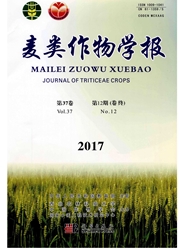

 中文摘要:
中文摘要:
为给南方麦区小麦合理施氮提供理论依据,在太湖流域典型地区的两年3季稻麦施肥量定位试验基础上,研究了施氮量与小麦产量、小麦吸氮量、土壤剖面无机氮素含量的关系。结果表明,随着施氮量的增加,小麦的产量、干物质积累量和氮素积累量都呈增大趋势,而氮肥的表观利用率、生理利用效率和农学利用效率都减小,施氮量225-300 kg.hm^-2是小麦高产、氮相对高效的适宜施氮量。小麦不同生育时期土壤剖面无机氮素主要集中在0-30 cm土层,且随着施氮量增加而增加。30-100 cm土层无机氮素对施氮量300-375 kg.hm^-2有明显的响应,拔节期以后已有明显的淋溶现象。施氮量300-375 kg.hm-2土壤中无机氮素的残留量一直较高,小麦成熟期土壤无机氮量与播种前的相比,除施氮量375 kg.hm^-2处理仍在增加外,施氮量小于300 kg.hm^-2的处理均有所减少。小麦-土壤系统氮素表观损失量随着施氮量的增加而增大,施氮处理75和375 kg.hm^-2的损失量分别为26.20和168.64 kg.hm^-2,损失率(占相应的施氮量)分别为34.93%和44.97%。施氮量225 kg.hm^-2是本地区小麦生态安全的临界施氮量。
 英文摘要:
英文摘要:
Taihu Lake region is one of the most high yield agriculture areas of China, the nitrogen application rate in the farm land is always higher. In order to find out the effects of nitrogen application rate (NAR) on wheat and the inorganic nitrogen in soil profile (INISP) of southern China wheat region, the optimal nitrogen application rate and the located nitrogen fertilizer experiment in the rotation of rice and wheat were studied in the experiment station of Farming and Forestry Bureau of Wujiang County, Suzhou city, Jiangsu province, China. The treatments of different nitrogen application rate were0, 75, 150, 225, 300 and 375 kg. hm 2, and were respectivelyindicat byN75, N150, N225, N300andN375. The nitrogen fertilizer was divided in two times application with the proportion of 60% as basal fertilizer and 40% as broadcasting injointing stage. On the NAR located experiments in rice wheat rotation of three seasons in two years in Taihu Lake region, the relationships between NAR, nitrogen accumulation in wheat, the changes of INISP and the nitrogen balance and the cumulate effect of INISP in different growth stages of wheat were measured after the wheat season. The result showed that- with the NAR increasing, wheat yield, dry matter accumulation and nitrogen accumulation all increased, but NARE, NPUE and NAUE all decrease, the NAR from 225 kg.hm^-2 to 300 kg.hm^-2 would get high yield, and were the optimum NAR when nitrogen was relatively higher effects; the INISP mostly concentrated in 0-30 cm soil and increased with the NAR increasing at different growth stages of wheat, the inorganic nitrogen in 30-100 cm soil obviously responded to the NAR from 300 kg. hm^-2 to 375 kg.hm^-2, it had obviously eluviations after jointing stage; the INISP of NAR from 300 kg.hm^-2 to 375 kg.hm^-2 was always higher, compared with the INISP in maturity stage and in sowing stage, it increased only in the treatment of NAR 375 kg . hm^-2, but all decreased when the NAR was below 300 kg.hm^-2; the nitrogen apparent losses increased
 同期刊论文项目
同期刊论文项目
 同项目期刊论文
同项目期刊论文
 期刊信息
期刊信息
